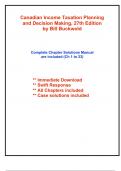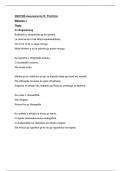Canadian Income Taxation Planning
and Decision Making, 27th Edition
by Bill Buckwold
Complete Chapter Solutions Manual
are included (Ch 1 to 23)
** Immediate Download
** Swift Response
** All Chapters included
** Case solutions included
,Table of Contents are given below
Chapter 1 Taxation—Its Role in Decision Making
Chapter 2 Fundamentals of Tax Planning
Chapter 3 Liability for Tax, Income Determination, and Administration of
the Income Tax System
Chapter 4 Income from Employment
Chapter 5 Income from Business
Chapter 6 The Acquisition, Use, and Disposal of Depreciable Property
Chapter 7 Income from Property
Chapter 8 Gains and Losses on the Disposition of Capital Property—
Capital Gains
Chapter 9 Other Income, Other Deductions, and Special Rules for
Completing Net Income for Tax Purposes
Chapter 10 Individuals: Determination of Taxable Income and Taxes
Payable
Chapter 11 Corporations—An Introduction
Chapter 12 Organization, Capital Structures, and Income Distributions of
Corporations
Chapter 13 The Canadian-Controlled Private Corporation
Chapter 14 Multiple Corporations and Their Reorganization
Chapter 16 Limited Partnerships and Joint Ventures
Chapter 17 Trusts
Chapter 19 Business Acquisitions and Divestitures—Tax-Deferred Sales
Chapter 20 Domestic and International Business Expansion
Chapter 21 Tax Aspects of Corporate Financing
Chapter 22 Introduction to GST/HST
Chapter 23 Business Valuations
,The Solutions manual organized in reverse order, with the last chapter
displayed first, to ensure that all chapters are included in this
document. (Complete Chapters included Ch.23-1)
CHAPTER 23
BUSINESS VALUATIONS
SOLUTIONS TO REVIEW QUESTIONS
1. The key factor that influences the value of a going concern business is its income earning
potential. The essence of a business operation is that it consists of a number of assets
(both physical and intangible) that work together for the purpose of generating a long-term
stream of profits.
2. The earnings approach attempts to value a business by examining the expected profits
that can be generated from the entity's total assets working together. In other words, the
combined value of all of its assets is a function of their income generating potential.
Valuing a business by the earnings approach assumes that assets are acquired to be
used in a going concern business as opposed to being acquired for the purpose of resale
at a profit. Therefore, it is appropriate to use this method of valuation when it is
anticipated that the business sold will continue to operate as a going concern.
In comparison, the asset approach to valuations involves the separate valuation of each
individual asset within the entity. It assumes the asset's primary value is its expected
selling price rather than its contribution to generating business income. It, therefore, has
limited application. Normally, this method applies to the valuation of passive investments
or a corporation holding a group of passive investments. It may also be relevant for the
valuation of a business entity that will not be sold as a going concern due to inadequate
profitability.
Keep in mind that an entity may have more than one type of activity within it. In valuing
that entity, it may be necessary to apply the earnings approach and the asset approach
separately to each activity.
3. The capitalization of earnings method establishes the total value of a business by
estimating the expected annual profits and capitalizing that amount based upon an
appropriate rate of return. For example, if anticipated profits are $50,000 annually and a
normal rate of return from investing in that type of business is 20%, the capitalized value
of the business is $250,000 ($50,000/.20). In other words, a price of $250,000 would yield
a 20% return on investment. Both the determination of the expected future profits and the
appropriate rate of return required for the investment are extremely subjective.
Consequently, the value of a business as perceived by the vendor may vary considerably
from the value perceived by the purchaser.
4. The ability to generate a specific amount of future profits varies with each business.
Therefore, the risk of investing in different businesses also varies. The capitalization of
earnings method attempts to account for this risk through the capitalization rate or
expected rate of return. The acceptable rate of return that is required to compensate for
the risk of achieving the potential profits is referred to as the capitalization rate. A high-risk
business requires a greater rate of return than a low risk business. For example, a high-
1
, risk business with expected profits of $50,000 annually may dictate a rate of return of 30%
to justify the risk, resulting in a value of $167,000 ($50,000/.30). On the other hand, a low
risk business with the same expected profits may require only an 18% rate of return to
justify the investment, resulting in a value of $278,000 ($50,000/.18).
5. The capitalization rate, which reflects the relative risk of the investment, can also be
expressed in terms of an earnings multiple. For example, a business with potential profits
of $50,000 and a capitalization rate of 20% is valued at $250,000 ($50,000/.20). Notice
that the value of $250,000 is equivalent to five times the annual earnings of $50,000.
Similarly, a capitalization rate of 25% ($50,000/.25 = $200,000) is equivalent to four times
annual profits ($50,000 x 4 = $200,000). It is common to express the value of a business
as an earnings multiple rather than as a capitalization rate although both have the same
effect. In effect, the earnings multiple is simply an expression of the capitalization rate
which is tied to the relative risk of the business.
6. The capitalization rate reflects the degree of certainty of achieving future profits. As future
events cannot be anticipated with certainty, the process of establishing risk is extremely
subjective. In most cases, a decision-maker will not be comfortable with a specific rate,
but rather will attempt to establish the range of rates that most closely reflects the
economic realities of the business being evaluated. In establishing this range,
the following types of factors may be relevant:
past history of profits achieved.
market potential for products sold or services provided.
the production capabilities and potential impact of technological changes on
production efficiency.
availability of material supplies and skilled labour.
the state of the competition.
strength and depth of management.
domestic and international economic trends, life cycle of primary products
manufactured and research and development capabilities.
7. The statement is not true. As a purchaser is acquiring a stream of future profits, it is
necessary to project the entity's earning capacity. Obviously, this process is speculative
and subject to inaccuracies. A review of past profits can be a relevant factor in estimating
the future. A mature business with a track record of proven profitability can project its
profits with greater confidence than a business in its early stages of growth. Therefore, in
an established business, the immediate past profits can be used for estimating future
profits.
However, it is important to recognize that the use of historical profits in the valuation
process is only useful to the extent that they reflect future expectations. Historical profits
often represent only a starting point from which realistic projections can be made.
8. The stated historical profits may not reflect the actual profits from the business operation
and may include a number of items (revenues and expenses) which are unusual or
non-recurring. In addition, closely held private corporations often include a number of
discretionary expenses, such as owner’s compensation, which may not be related to
economic reality. Therefore, past profits, when used in a valuation process, must be
examined and adjusted to eliminate those items which distort the true profits earned
2





